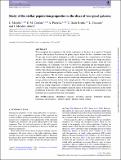Study of the stellar population properties in the discs of ten spiral galaxies
View/
Date
11/09/2015Funder
Grant ID
ERC-2012-StG-20111012
Keywords
Metadata
Show full item recordAbstract
We investigated the properties of the stellar populations in the discs of a sample of 10 spiral galaxies. Our analysis focused on the galaxy region where the disc contributes more than 95 per cent of total surface brightness in order to minimize the contamination of the bulge and bar. The luminosity-weighted age and metallicity were obtained by fitting the galaxy spectra with a linear combination of stellar population synthesis models, while the total overabundance of α-elements over iron was derived by measuring the line-strength indices. Most of the sample discs display a bimodal age distribution and they are characterized by a total [α/Fe] enhancement ranging from solar and supersolar.We interpreted the age bimodality as due to the simultaneous presence of both a young (Age≤4 Gyr) and an old (Age>4 Gyr) stellar population. The old stellar component usually dominates the disc surface brightness and its light contribution is almost constant within the observed radial range. For this reason, no age gradient is observed in half of the sample galaxies. The old component is slightly more metal poor than the young one. The metallicity gradient is negative and slightly positive in the old and young components, respectively. These results are in agreement with an inside-out scenario of disc formation and suggest a reduced impact of the radial migration on the stellar populations of the disc. The young component could be the result of a second burst of star formation in gas captured from the environment.
Citation
Morelli , L , Corsini , E M , Pizzella , A , Dalla Bontà , E , Coccato , L & Mendez Abreu , J 2015 , ' Study of the stellar population properties in the discs of ten spiral galaxies ' , Monthly Notices of the Royal Astronomical Society , vol. 452 , no. 2 , pp. 1128-1139 . https://doi.org/10.1093/mnras/stv1357
Publication
Monthly Notices of the Royal Astronomical Society
Status
Peer reviewed
ISSN
0035-8711Type
Journal article
Description
This work was supported by Padua University through grants 60A02-4807/12, 60A02-5857/13, 60A02-5833/14, and CPDA133 894. LM acknowledges financial support from Padua University grant CPS0204. JMA acknowledges support from the European Research Council Starting Grant (SEDmorph, P.I. V. Wild)Collections
Items in the St Andrews Research Repository are protected by copyright, with all rights reserved, unless otherwise indicated.
Related items
Showing items related by title, author, creator and subject.
-
SDSS-IV MaNGA: How the stellar populations of passive central galaxies depend on stellar and halo mass
Oyarzún, Grecco A.; Bundy, Kevin; Westfall, Kyle B.; Tinker, Jeremy L.; Belfiore, Francesco; Argudo-Fernández, Maria; Zheng, Zheng; Conroy, Charlie; Masters, Karen L.; Wake, David; Law, David R.; McDermid, Richard M.; Aragón-Salamanca, Alfonso; Parikh, Taniya; Yan, Renbin; Bershady, Matthew; Sánchez, Sebastián F.; Andrews, Brett H.; Fernández-Trincado, José G.; Lane, Richard R.; Bizyaev, D.; Boardman, Nicholas Fraser; Lacerna, Ivan; Brownstein, J. R.; Drory, Niv; Zhang, Kai (2022-07-06) - Journal articleWe analyze spatially resolved and co-added SDSS-IV MaNGA spectra with signal-to-noise ratio ∼100 from 2200 passive central galaxies (z ∼ 0.05) to understand how central galaxy assembly depends on stellar mass (M*) and halo ... -
Secular-and merger-built bulges in barred galaxies
Mendez Abreu, Jairo; Debattista, V. P.; Corsini, E. M.; Aguerri, J. A. L. (2014-12) - Journal articleContext. Historically, galaxy bulges were thought to be single-component objects at the center of galaxies. However, this picture is now questioned since different bulge types with different formation paths, namely classical ... -
Galaxy And Mass Assembly (GAMA) : galaxy close pairs, mergers and the future fate of stellar mass
Robotham, A. S. G.; Driver, S. P.; Davies, L. J. M.; Hopkins, A. M.; Baldry, I. K.; Agius, N. K.; Bauer, A. E.; Bland-Hawthorn, J.; Brough, S.; Brown, M. J. I.; Cluver, M.; De Propris, R.; Drinkwater, M. J.; Holwerda, B. W.; Kelvin, L. S.; Lara-Lopez, M. A.; Liske, J.; Lopez-Sanchez, A. R.; Loveday, J.; Mahajan, S.; McNaught-Roberts, T.; Moffett, A.; Norberg, P.; Obreschkow, D.; Owers, M. S.; Penny, S. J.; Pimbblet, K.; Prescott, M.; Taylor, E. N.; van Kampen, E.; Wilkins, S. M. (2014-11-11) - Journal articleWe use a highly complete subset of the Galaxy And Mass Assembly II (GAMA-II) redshift sample to fully describe the stellar mass dependence of close pairs and mergers between 10(8) and 10(12)M(circle dot). Using the analytic ...

